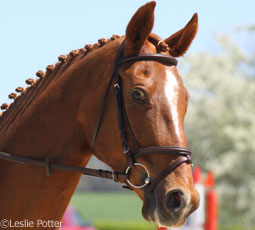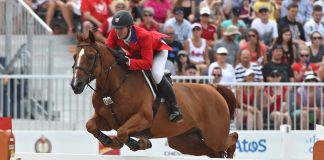 |
| The vast majority of show jumpers observed in a study used flash nosebands, as shown above, or figure-eight style rather than the plain cavesson type. Photo: Leslie Potter |
When learning to properly tack up a horse, most English riders are taught to keep the noseband loose enough to allow space for two fingers to fit in between the leather and the horse’s nose. As a spectator at some equestrian events, you may have wondered if all riders follow that rule. Recent research looked at how competitive riders adjust their horse’s nosebands and how that could affect horse welfare.
The researchers sought to find out if these tight nosebands were doing physical harm or otherwise compromising equine welfare. In order to do so, they developed two methods to measure actual pressure applied by the noseband while in use. One measured tension in the noseband and inferred pressures based on the curvature of the horse’s nose. The second used pressure sensors at specific points on the noseband.
These methods were used to measure pressure on a horse outfitted with a noseband adjusted to fit two fingers. Measurements were taken when the horse chewed hay and feed and when he was cued to back up. The same horse was then ridden at a walk, trot, canter and over a small jump. The researchers observed large pressure pulses that correlated to transitions, turns, while jumping and when the horse stumbled. This preliminary study was not intended to discern whether or not there was physical damage as a result of the pressure, although high pressure is known to cause tissue and nerve damage in humans, so the same might be true of horses.
With more testing, these pressure measures may be able to help determine if noseband tightness results in injury or compromises horse welfare.
“We really don’t know what happens to soft tissues when we tighten the noseband,” says Doherty. “If the horse physically can’t open its mouth, then are the fluctuations in pressure or force going to be greater or less or displaced to the bit-oral cavity interface? Much remains to be done to answer these questions.”
Read more at EquitationScience.com






I hate the too-tight nosebands so many people use! If the horse can’t chew, he can’t properly respond to the bit. Plus, it’s just plain mean to clamp their mouth shut!
I feel the same way, Ellen. To me it is so cruel, also people who do not change out the foal halters. do damage to the tender nose bones.
Well, what do you expect? A too tight noseband is no worse than a metal bit, a too tight girth, and whips. People are just plain cruel to horses, and that’s the way it is, and will forever be.
interesting don’t use nosebands know I won’t in future
ok soooo…… what does this prove? they didn’t come to a real conclusion!
I prefer not to use a noseband at all.
I do not use a nose, band, whips, spurs, or a bit…its called “oneness” with your horse, but not everyone has the time I do.
Thank you for letting folks know about this abusive pratice.
I’m a lower-level dressage rider, but I always make sure two fingers fit under the noseband, and I don’t use a flash noseband. The only reason I use a noseband at all is because its required at shows. Every trainer I’ve used has always said that you should be able to fit two fingers under the noseband. Sadly, I do know people who do use a tight noseband.
Why do people even need a noseband? Or a bit for that matter? I ride in a bosal or a rope halter and it works fine…
Glad to see it, but as a performance horse coach, the number one thing I do to assist in behavioral issues such as getting too quick, pulling, or refusing to go forward is to loosen or remove the noseband. Stallions seem to have less problems as they have stronger jaws and muscles in this area due to their natural ability to fight using their mouths. Mares, however have softer muscles and higher tactile pro-preception used for nurturing so they often will object to tightness in this area before a stallion or gelding. I have over 30 years of data as a equine ecologist on this topic and one of my books addressing “Stress in Horses” addresses stress caused from bad fitting tack and tight nosebands